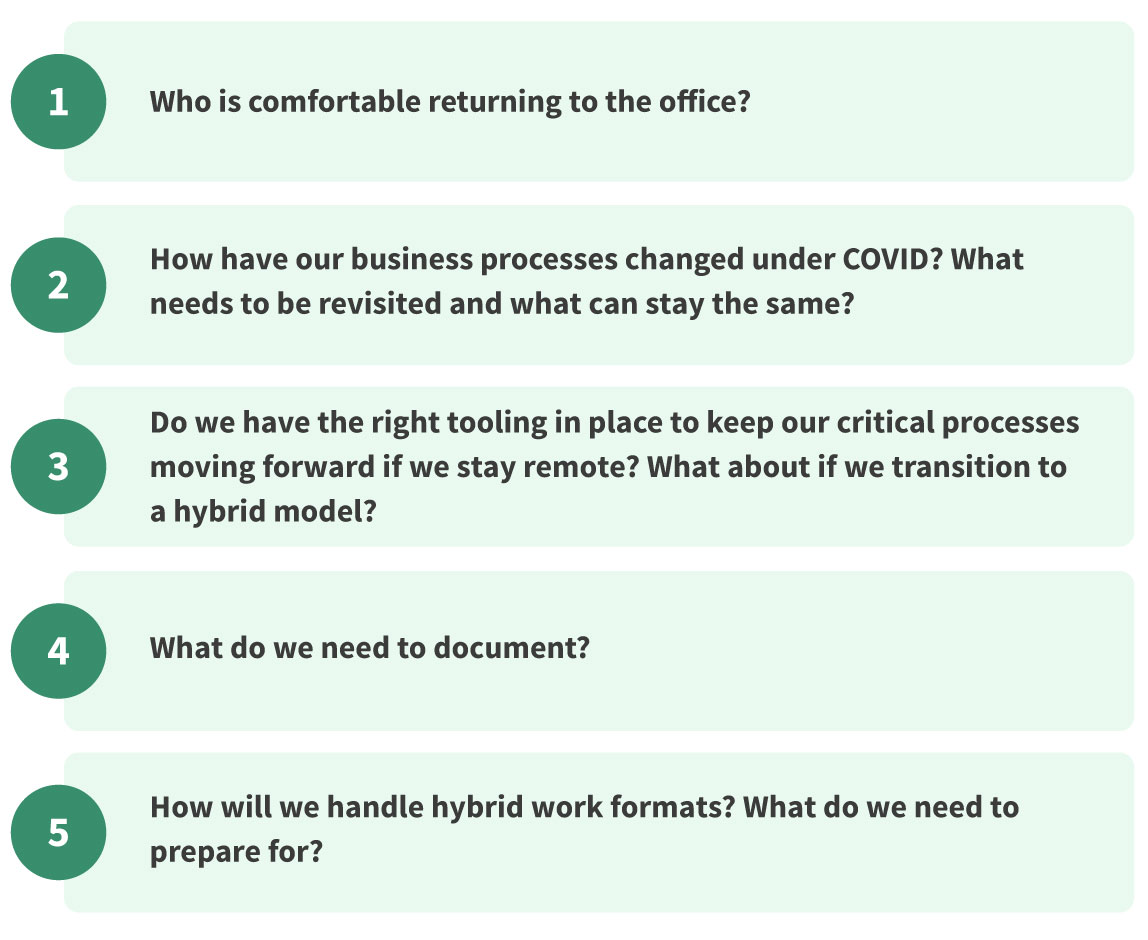A 2020 Pew Research poll revealed that half of employees would choose to continue working from home after the pandemic if given the option. Therefore, you can anticipate that there are some employees at your organization who may not want to return to the office at all, or have differing levels of comfort returning to in-person work.
Utilize surveys to help understand where your organization stands. Ask employees what they’re comfortable with and what their ideal work situation looks like. Use this data to inform and shape your return to office plans and, importantly, indicate that you are aware of employee sentiment and are taking that into consideration. Then, at regular intervals and as things change, re-survey to understand how things are progressing and if you need to modify any new policies.
How have our business processes changed under COVID? What needs to be revisited and what can stay the same?
For some companies, the transition to a remote working environment led to efficiencies and increased productivity–such as shorter and more focused meetings.
Consider what your company learned over the course of the past year to determine what processes you can keep as is and which processes need to be revisited, depending on your return to office plans. One way to prioritize process changes is to align them with your 2021 and early 2022 goals or initiatives.
Do we have the right tooling in place to keep our critical processes moving forward if we stay remote? What about if we transition to a hybrid model?
The abrupt transition to an all remote working environment underscored that paper-based processes are impossible to maintain and create additional work and headache for teams. If you are considering staying remote or implementing a hybrid model, having the right cloud-based tools in place will be essential so all teams can stay on track.
For example, software can boost productivity and improve efficiencies for key processes within life science organizations, such as:
- Promotional review: software allows you to review and approve new ad/promo content quickly, no matter where your teams are. Here are additional tips on how to achieve a fast, efficient content review process while working remotely.
- Sales enablement: software allows you to equip sales teams and MSLs with approved content they can use to engage KOLs and HCPs during virtual and in-person meeting environments.
What do we need to document?
For any change management initiative, having clear and consistent communication is key. Consider and keep track of new documents that need to be created to support any changes in policy and procedure. Circulate those documents throughout the organization so everyone has a clear understanding of what is changing and why. It’s ok to consider any new policies or procedures as “living” documents that are subject to revision at any time, just make sure to communicate those instances to your employees.
How will we handle hybrid work formats? What do we need to prepare for?
If you’re considering moving to a hybrid work format, consider how to create an even playing field for both in-person and remote employees.
For example, approach meetings and presentations with remote workers in mind:
- Develop and circulate agendas or meeting objectives ahead of time
- Open the Zoom meeting early so remote workers can sign in and get situated while people file into any conference rooms
- Make direct eye contact with both in-person and remote meeting attendees
- If using break out sessions, combine both in-person and remote workers in groups to foster collaboration
Remember: flexibility is key
As you implement new policies and procedures for an in-office, hybrid, or even a continued remote environment, be deliberate in your changes and avoid moving too quickly or trying to achieve the same working environment that you maintained pre-covid. Revisit new policies and procedures regularly to understand what is working and what’s not. Don’t expect to have all of the answers, but instead engage your employees regularly to get their thoughts and ideas to make any new working arrangements work for everyone.



